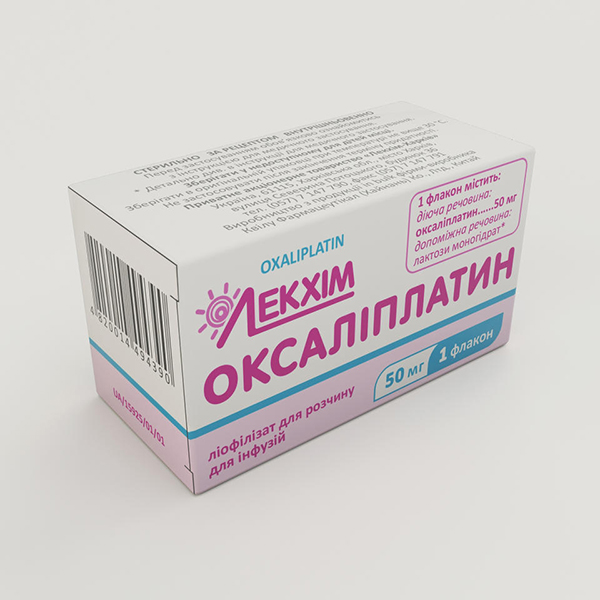Oxaliplatin

OXALIPLATIN
(OXALIPLATIN )
Storage:
active substance: oxaliplatin;
1 bottle contains 50 mg or 100 mg of oxaliplatin;
excipient: lactose monohydrate.
Medicinal form. Lyophilisate for solution for infusions.
Main physicochemical properties: white or almost white loose mass or powder.
Pharmacotherapeutic group. Antineoplastic agents. Platinum compounds. Oxaliplatin.
ATX code L01X A03.
Pharmacological properties.
Pharmacodynamics.
The antineoplastic agent oxaliplatin (cis-[oxalato(trans-1-1,2-diaminocyclohexane) platinum]) belongs to a new class of platinum compounds in which the platinum atom forms a complex with 1,2-diaminocyclohexane (DACH) and an oxalate group. Oxaliplatin is an enantiomer.
Oxaliplatin exhibits cytotoxic effects in vitro and antitumor effects in vivo against a wide range of test systems, including models of human colorectal cancer. Oxaliplatin has been shown to have in vitro and in vivo activity against various cisplatin-resistant cancer models.
With the combined use of oxaliplatin and 5-fluorouracil in vitro and in vivo , a synergistic cytotoxic effect is observed.
The mechanism of action of oxaliplatin has not been fully elucidated, but studies have shown that water derivatives formed during the biotransformation of oxaliplatin interact with DNA and cause the formation of interstrand and intrastrand crosslinks in DNA, as a result of which DNA synthesis is disrupted and cytotoxic and antitumor effects are observed.
Pharmacokinetics .
The pharmacokinetics of individual active metabolites were not studied. Pharmacokinetic parameters for ultrafiltered platinum (mixtures of all unbound, active and inactive platinum compounds) after two-hour infusions of oxaliplatin at a dose of 130 mg/m2 body surface area every 3 weeks (1-5 courses) or at a dose of 85 mg/m2 body surface area every 2 weeks (1-3 courses) are given in table 1.
At the end of the two-hour infusion, 15% of the injected platinum is in the systemic circulation, and 85% is quickly distributed in the tissues or excreted in the urine. As a result of irreversible binding to erythrocytes and blood plasma albumin, the half-life periods of platinum in these compounds are close to the time of natural renewal of erythrocytes and blood plasma albumin. When oxaliplatin is administered every 2 weeks at a dose of 85 mg/m2 of the body surface or every 3 weeks at a dose of 130 mg/m2 of the body surface, there is no accumulation of platinum in the ultrafiltrate of the blood plasma, and the equilibrium state is reached already after the first course of therapy. Inter- and intrasubject variability of pharmacokinetic indicators is generally small.